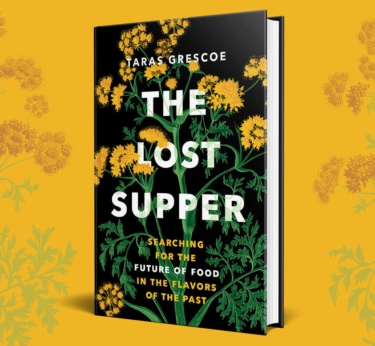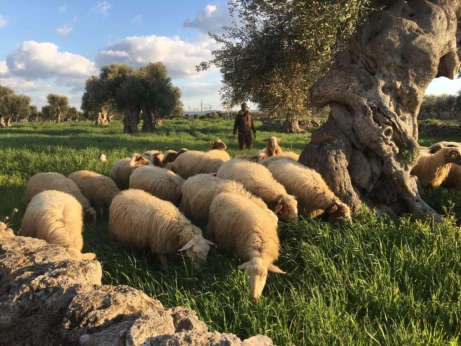Opinion: To Find the Future of Food, We Need to Look to the Past
Feb 20, 2024
In his new book, The Lost Supper, author Taras Grescoe argues that we’ve become too far removed from farming and food production. The best hope for ensuring food security in the future lies in reacquainting ourselves with the lost and neglected agricultural practices from the past.

The author in Turkey, at the site where some of the first daily bread was baked.
Photography submitted.
The following is excerpted from Taras Grescoe’s The Lost Supper, and has been lightly edited for length and clarity.
There were times during this voyage that it seemed humanity was driving down an alley toward a brick wall, fast. Catastrophe loomed everywhere I looked: in the dust bowls on the once-fertile plains of central Turkey, in the vanishing lakes of Mexico City, in the fetid cesspools outside the factory farms of North Carolina, in the disease-ravaged olive trees of Puglia, in the rapid wiping away of diverse food webs in every biome. The demographers’ scenario, where we’ll have to produce 50 percent more food by midcentury to feed a population of ten billion or face famine, sometimes seemed like the only possible outcome.
For the time being, our cunning plan seems to be to wait until the last second and hope an airbag will deploy to cushion us from the final impact. In modern times, there’s a long tradition of techno-optimists or cornucopians–science writer Charles C. Mann calls them “wizards”–telling us that technology will come to our rescue. In the 1930s, Winston Churchill predicted in the pages of a Canadian magazine that future famines would be averted by raising edible bacteria in underground cellars using artificial radiation. Others saw yeast factories and transcontinental algae pipelines nourishing the domed metropolises of the 21st century.
According to the techno-optimists, hacking photosynthesis by genetically modifying rubisco, the enzyme found in all plants that turn sunlight and carbon dioxide into starches, proteins, and other nutrients will allow us to radically increase rice yields in Asia. Growing perennial grasses, rather than annuals like wheat, will permit us to mow the cereals we eat rather than cutting them down whole, thus keeping root systems intact and putting an end to soil degradation. Using robots to milk cows and drones for the precision irrigation of crops will save labor costs and conserve water. And growing meat in the lab, from cultured stem cells in bioreactors will eliminate the need for raising livestock, and all the environmental havoc that goes with it.
A closer look, though, shows that most of these techno fixes have serious downsides. Perennial wheat, marketed as Kernza, doesn’t have enough gluten to make bread or pasta; robot-milking systems don’t allow for pasture feeding, requiring cows to remain in barns year-round for the system to be profitable. Venture capitalists have poured $3 billion into the lab-grown meat industry, yet the resulting products have to be bulked up with plant protein, and are still far from palatable. As for Churchill’s plan to raise bacteria in caves, it’s back in the form of journalist George Monbiot’s plan for curing “agricultural sprawl” and feeding the billions: calories will once again be plucked out of the air, as Scandinavian labs use electricity and “precision fermentation” to transform bacteria into gray protein pancakes.

My response to the techno-optimists and wizards who tell us that we should all subsist on a diet of bacteria, yeast, cultured meat, or algae is: you go first. And by that I don’t mean take the first bite. (As an adventurous eater. I’ll try anything once.) I mean, show me that you can survive and thrive on that diet for five, ten, or 20 years. Then I might consider joining you.
I’ve noticed something about “scientifically improved” foods. To put it bluntly: nobody wants to eat that shit. The first approved transgenic vegetable, the slow-ripening rot-resistant Flavr Savr tomato, engineered with genes from a bacterial parasite, was a commercial flop, losing millions for the company that developed it. Golden rice, engineered to contain higher levels of beta-carotene, and the Arctic Apple, designed not to brown when cut, have also failed to attract farmers and consumers.
It turns out that what people do want to eat when they’re given any kind of choice, and are able to afford it, is non-GM food. The market for organic food, which has more than doubled in a decade, accounted for $58 billion in sales in 2021 in the United States alone.
If we’re really serious about forestalling famine, we need to stop feeding so much grain to livestock, and save the wheat, corn, and rice we grow for human consumption. Edible insects are already being used to feed poultry and farmed fish, but they could also be included in the feed of cattle and pigs. The black soldier fly is an efficient, fast growing converter of organic waste into protein for animal feed. I interviewed Kieran Olivaraes Whitaker, the founder of the British company Entocycle, who has succeeded in raising millions of flies in a tiny rented space in the center of London. The entirely automated operation used the waste from breweries to feed the bugs; the black soldier flies can be used to boost the protein content in feed for cattle, poultry, pigs, and farmed fish. This approach makes a lot more sense to me than hoping humans will suddenly acquire a taste for bug-burgers.
But raising insects for feed is a patch, not a solution. The Food and Agriculture Organization of the United Nations has made it clear that for the time being, food producers pump out enough calories to feed everybody on Earth. It’s equally clear that the billions of inhabitants of the “Global South” aren’t the problem. It’s the people in the world’s rich nations, as well as the growing middle classes in Asia, Latin America, and Africa, who consume diets high in processed foods and grain-fed meat and dairy that keep us hurtling toward that brick wall.

Puglia, in southern Italy, taught Grescoe about both olive trees and the ancient tradition of shepherding. Photo submitted.
In the final months of writing this book, I was lucky enough to spend a few weeks surrounded by wheat fields. I was staying in the foothills of the Jura Mountains, in the canton of Vaud, a part of Switzerland that prides itself on sustainable organic agriculture. Many of the farms were centuries old. The entire landscape seemed devoted to turning the richness of the soil into fantastically delicious foods. I witnessed the age-old transhumance, in which Simmental, Jersey, and Charolais cows were transported to summer pastures in alpine meadows more than 4,000 feet in altitude, where they fed on wild flowers and lush grass to produce the exquisite Gruyère, Tomme, and Vacherin cheeses sold in village fromageries.
I’d arrived in mid-May, just as the reddish-orange poppies were blooming. On daily bike rides, I got to see the spring wheat planted in fields all around me mature from a lustrous green to a sharkskin amber. I recalled the criticism leveled against wheat: that it’s one of humanity’s most egregious examples of a monocrop. But in the Vaud, the fields were relatively small, a few dozen acres at most, and people were careful to plant fruit and nut-bearing trees alongside the edges. A local initiative had dotted jachères, richly diverse plots of native grasses and wildflowers that encouraged birds to nest and insects to gather pollen, in random spots among the wheat fields.
Being in Switzerland was a reminder that agriculture need not be the problem. Done properly, it was the solution to our diversity and sustainability crisis. There was a world of other great practices out there, sometimes referred to as regenerative farming, biointensive agriculture, agroforestry, or permaculture, like the mixed mountain farming champion Sepp Holzer, an Austrian advocate of farming on marginal land.
Even if we aren’t in a position to grow our own food, there are straightforward ways we can all become responsible eaters. The poet and essayist Wendell Berry laid out seven principles in his influential 1989 essay “The Pleasures of Eating.” Prepare your own food; learn where the food you buy comes from; deal directly, whenever possible, with local farmers, gardeners and orchardists. In self-defense, teach yourself about the economy and technology of food production and how industry adds to and alters food. Learn what is involved in the best farming, as well as in the life histories of food species. First and foremost, participate in food production, even if that means nothing more than growing herbs or tomatoes on a kitchen windowsill.
In Switzerland, I remembered the wheat fields I’ve known on the Canadian Prairies and the Great Plains, which can cover 30,000 acres, so vast that walking from one edge to the other can take three hours. Planted with dwarf hybrid varieties, sprayed with pesticides, and shocked dead with glyphosate for easier harvesting by combines, this was the kind of landscapes the critics of industrial agriculture decry: one devoid of diversity, dead except for the one plant species that happens to be valued by modern humans: wheat. It was a stark contrast to the Swiss countryside, where agriculture was practiced in a way that kept the soil healthy, and the land and air alive with animal, plant, and insect life.
If humans are defined as the species that adapts to new environments, we’ve fulfilled our destiny to the extent that we now find ourselves adapted to impoverished environments entirely of our own making. The monocultures of wheat, rice, corn, and soybeans that feed us depend for their success on the elimination of biodiversity. But diversity is what confers resiliency, and by simplifying natural habitats to serve the needs of industrial agriculture, we’ve left ourselves open to pandemics, supply-chain-disrupting wars, droughts, floods, and new crop and livestock diseases. Our determination to feed everyone on the planet cheaply has already resulted in malnourishment for the masses. If we don’t change our ways, it could soon lead to hunger for all.
Taras Grescoe is a Montreal-based journalist and author. He is the author of Straphanger, Bottomfeeder, and The Devil’s Picnic. He writes about the history of food on lostsupper.blog.
https://modernfarmer.com/2024/02/opinion-to-find-the-future-of-food-we-need-to-look-to-the-past/